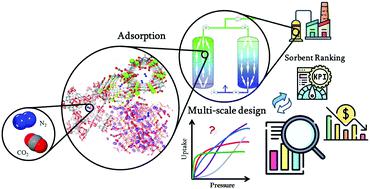当前位置:
X-MOL 学术
›
Energy Environ. Sci.
›
论文详情
Our official English website, www.x-mol.net, welcomes your
feedback! (Note: you will need to create a separate account there.)
Are we missing something when evaluating adsorbents for CO2 capture at the system level?
Energy & Environmental Science ( IF 32.4 ) Pub Date : 2021-09-13 , DOI: 10.1039/d1ee01677f Hammed A. Balogun 1, 2, 3 , Daniel Bahamon 1, 2 , Saeed AlMenhali 1, 2 , Lourdes F. Vega 1, 2 , Ahmed Alhajaj 1, 2
Energy & Environmental Science ( IF 32.4 ) Pub Date : 2021-09-13 , DOI: 10.1039/d1ee01677f Hammed A. Balogun 1, 2, 3 , Daniel Bahamon 1, 2 , Saeed AlMenhali 1, 2 , Lourdes F. Vega 1, 2 , Ahmed Alhajaj 1, 2
Affiliation

|
Adsorption of CO2 with porous solid materials is gaining attention as a promising CO2 capture technology due to the potential improvement in energy efficiency and cost reductions. This study investigates for the first time the potential performance of the MOFs Cu-BTC, Mg-MOF-74, and UTSA-16 for CO2 capture at a commercial large-scale using multiscale modeling; in addition, a selected activated carbon was included for comparative purposes, and zeolite 13X was used as the benchmark. We have developed a multiscale model that integrates molecular simulation results with a process model of a pressure/vacuum swing adsorption (P/VSA) process. The model was first validated at the pilot scale and then used to assess the performance of the above-mentioned adsorbents and processes attached to a 550 MW coal plant, in order to achieve the 90% recovery and 95% purity targets of the US Department of Energy. The optimal design, scheduling and operating conditions of these adsorbents were obtained while minimizing total cost and improving the non-monetized key performance indicators (KPIs) such as productivity, selectivity, working capacity, energy consumption and the modified adsorption figure of merit (AFM) obtained in global sensitivity analyses. A key finding from this study is that the recently proposed UTSA-16 MOF can be as good as the traditional zeolite 13X for industrial-scale post-combustion capture and compression, at a cost of <$45 tCO2−1 and an energy consumption of <550 kW h e tCO2−1. It is also shown that, sometimes, using specific KPIs for the evaluation of adsorbents can lead to misleading results as the overall performance depends on the dynamics of the operating conditions at the cyclic steady state, the material cost, the scheduling and the column geometry. This study underlines the importance of utilizing a detailed multiscale model and system-level analysis for the reliable assessment of different adsorbents for industrial-scale carbon capture.
中文翻译:

在系统级别评估吸附剂的 CO2 捕获时,我们是否遗漏了什么?
用多孔固体材料吸附 CO 2作为一种有前途的 CO 2捕获技术,由于在能源效率和成本降低方面的潜在改进而受到关注。本研究首次调查了 MOFs Cu-BTC、Mg-MOF-74 和 UTSA-16 对 CO 2的潜在性能使用多尺度建模在商业大规模捕获;此外,为了比较目的,还包括了选定的活性炭,并使用沸石 13X 作为基准。我们开发了一个多尺度模型,该模型将分子模拟结果与变压/真空变压吸附 (P/VSA) 过程的过程模型相结合。该模型首先在中试规模上进行了验证,然后用于评估上述吸附剂和连接到 550 MW 燃煤电厂的工艺的性能,以实现美国能源部 90% 的回收率和 95% 的纯度目标。活力。获得这些吸附剂的最佳设计、调度和操作条件,同时最大限度地降低总成本并提高非货币化的关键性能指标 (KPI),如生产率、选择性、工作能力、在全球敏感性分析中获得的能量消耗和修正的吸附品质因数 (AFM)。这项研究的一个关键发现是,最近提出的 UTSA-16 MOF 在工业规模的燃烧后捕获和压缩方面可以与传统的 13X 沸石一样好,成本低于 45 美元t CO2 -1和<550 kW he t CO2 -1的能量消耗。还表明,有时使用特定 KPI 评估吸附剂会导致误导结果,因为整体性能取决于循环稳态下操作条件的动态、材料成本、调度和塔几何。这项研究强调了利用详细的多尺度模型和系统级分析对不同吸附剂进行工业规模碳捕获的可靠评估的重要性。
更新日期:2021-10-07
中文翻译:

在系统级别评估吸附剂的 CO2 捕获时,我们是否遗漏了什么?
用多孔固体材料吸附 CO 2作为一种有前途的 CO 2捕获技术,由于在能源效率和成本降低方面的潜在改进而受到关注。本研究首次调查了 MOFs Cu-BTC、Mg-MOF-74 和 UTSA-16 对 CO 2的潜在性能使用多尺度建模在商业大规模捕获;此外,为了比较目的,还包括了选定的活性炭,并使用沸石 13X 作为基准。我们开发了一个多尺度模型,该模型将分子模拟结果与变压/真空变压吸附 (P/VSA) 过程的过程模型相结合。该模型首先在中试规模上进行了验证,然后用于评估上述吸附剂和连接到 550 MW 燃煤电厂的工艺的性能,以实现美国能源部 90% 的回收率和 95% 的纯度目标。活力。获得这些吸附剂的最佳设计、调度和操作条件,同时最大限度地降低总成本并提高非货币化的关键性能指标 (KPI),如生产率、选择性、工作能力、在全球敏感性分析中获得的能量消耗和修正的吸附品质因数 (AFM)。这项研究的一个关键发现是,最近提出的 UTSA-16 MOF 在工业规模的燃烧后捕获和压缩方面可以与传统的 13X 沸石一样好,成本低于 45 美元t CO2 -1和<550 kW he t CO2 -1的能量消耗。还表明,有时使用特定 KPI 评估吸附剂会导致误导结果,因为整体性能取决于循环稳态下操作条件的动态、材料成本、调度和塔几何。这项研究强调了利用详细的多尺度模型和系统级分析对不同吸附剂进行工业规模碳捕获的可靠评估的重要性。











































 京公网安备 11010802027423号
京公网安备 11010802027423号